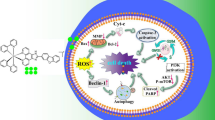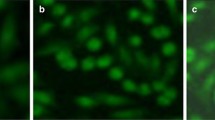Abstract
Two ruthenium(II) polypyridyl complexes formulated as [Ru(bpy)2(THPDP)](PF6)2 (1) and [Ru(ttbpy)2(THPDP)](PF6)2 (ttbpy = 4,4ʹ-ditertiary butyl-2,2ʹ-bipyridine) (2) were synthesized and characterized by elemental analysis, 1H NMR, 13C NMR and UV–Vis spectra. The cytotoxic activities of the complexes against cancer cell lines BEL-7402, A549, SGC-7901, HeLa and normal NIH3T3 cells were investigated by 3-(4,5-dimethylthiazole)-2,5-diphenyltetrazolium bromide (MTT) methods. The complexes show moderate cytotoxicity toward BEL-7402 and HeLa cells. The changes in mitochondrial membrane potential, intracellular Ca2+ and reactive oxygen species were studied by fluorescence microscopy. Both complexes can increase intracellular Ca2+ concentrations and ROS levels and induce a decrease in mitochondrial membrane potential. They also inhibit cell invasion and suppress cell proliferation at the G0/G1 phase. Additionally, they activate caspase 3, cleave PARP and regulate the expression of Bcl-2 family proteins. In short, the complexes induce apoptosis in BEL-7402 cells through a ROS-mediated mitochondria dysfunction pathway.










Similar content being viewed by others
References
Rosenberg B, VanCamp L, Trosko JE, Mansour VH (1969) Nature 222:385–386
Pasetto LM, Andrea MRD, Brandes AA, Rossi E, Monfardini S (2006) Crit Rev Oncol/Hematol 60:59–75
Hall MD, Telma KA, Chang KE, Lee TD, Madigan JP, Lloyd JR, Goldlust IS, Hoeschele JD, Gottesman MM (2014) Cancer Res 74:3913–3922
Kelland L (2007) Nat Rev Cancer 7:573–584
Siddik ZH (2003) Oncogene 22:7265–7279
Li YM, Wu Q, Yu GN, Li L, Zhao XH, Huang XT, Mei WJ (2019) Eur J Med Chem 164:282–291
Wan D, Tang B, Wang YJ, Guo BH, Yin H, Yi QY, Liu YJ (2017) Eur J Med Chem 139:180–189
Wan D, Lai SH, Zeng CC, Zhang C, Tang B, Liu YJ (2017) J Inorg Biochem 173:1–11
Tang B, Wan D, Lai SH, Yang HH, Zhang C, Wang XZ, Zeng CC, Liu YJ (2017) J Inorg Biochem 173:93–104
Tang B, Shen F, Wan D, Guo BH, Wang YJ, Yi QY, Liu YJ (2017) RSC Adv 7:34945–34958
Ypsilantis K, Plakatouras JC, Manos MJ, Kourtellaris A, Markopoulos G, Kolettas E, Garoufis A (2018) Dalton Trans 47:3549–3567
Chen JC, Zhang Y, Li GD, Peng F, Jie XM, She J, Dongye GZ, Zou ZL, Rong SW, Chen LM (2018) J Biol Inorg Chem 23:261–275
Cao WQ, Zheng WJ, Chen TF (2015) Sci Rep-UK 5:9157
Zeng CC, Lai SH, Yao JH, Zhang C, Yin H, Li W, Han BJ, Liu YJ (2016) Eur J Med Chem 122:118–126
Tang B, Wan D, Wang YJ, Yi QY, Guo BH, Liu YJ (2018) Eur J Med Chem 145:302–314
Sullivan BP, Salmon DJ, Meyer TJ (1978) Inorg Chem 17:3334–3341
Mosmann T (1983) J Immunol Methods 65:55–63
Zhang C, Han BJ, Zeng CC, Lai SH, Li W, Tang B, Wan D, Jiang GB, Liu YJ (2016) J Inorg Biochem 157:62–72
McBride HM, Neuspiel M, Wasiak S (2006) Curr Biol 16:R551–R560
Henze K, Martin W (2002) Nature 426:127–128
Laver DR (2007) Biophys J 92:3541–3555
Cadenas E, Davies KJA (2000) Free Radical Biol Med 29:222–230
Chou CC, Yang JS, Lu HS, Ip SW, Lo C, Wu CC, Lin JP, Tang NY, Chung JG, Chou MJ, Teng YH, Chen DR (2010) Arch Pharm Res 33:1181–1191
Adams JM (2003) Genes Dev 17:2481–2495
Duriez P, Shah GM (1997) Biochem Cell Biol 75:337–349
Acknowledgements
We are grateful to Science and Technology Project of Jiangxi Education Department in 2017 (No GJJ171024) and Jiangxi University of Technology for financial support.
Author information
Authors and Affiliations
Corresponding author
Additional information
Publisher's Note
Springer Nature remains neutral with regard to jurisdictional claims in published maps and institutional affiliations.
Rights and permissions
About this article
Cite this article
Liang, ZH., Wang, YN., Xiong, ZW. et al. Studies of the anticancer activities of ruthenium(II) polypyridyl complexes toward human hepatocellular carcinoma BEL-7402 cells. Transit Met Chem 44, 585–594 (2019). https://doi.org/10.1007/s11243-019-00315-5
Received:
Accepted:
Published:
Issue Date:
DOI: https://doi.org/10.1007/s11243-019-00315-5




